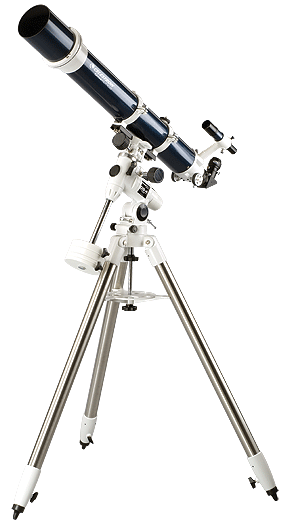How to Align a German Equatorial Mount for Visual Observing By Chuck Hawks  Equatorial (EQ) mounts, and particularly German equatorial mounts, are the best way to mount a portable telescope. These mounts allow easy tracking of objects as the rotation of the earth makes them appear to move across the sky in an arc. EQ mounts are designed to allow correction for the earth's rotation by adjustment in one plane, called "right ascension." Right ascension is the arc through which celestial objects appear to travel across the night sky. (Alt-azimuth mounts must be adjusted in two planes, azimuth and altitude, to counter the earth's rotation.) Motorized EQ mounts do this automatically, slowly turning the mount to cancel the earth's rotation. The operator of an EQ mount without a motor drive achieves the same thing by manual adjustment of the right ascension slow motion control to keep objects in the telescope's field of view. Any German EQ mount worth its salt incorporates either manual or motor driven slow motion controls in both the right ascension and declination (essentially up and down) planes, very important for both finding and keeping an object centered in the field of view. The use of Vixen, Losmandy or similar dovetail rails on the telescope allows it to be quickly attached and detached from the mount for transport. This is a precise, convenient way to mount an astronomical telescope. However, to accomplish this miracle of convenient tracking, EQ mounts must be at least approximately aligned with the celestial pole. For Northern Hemisphere observers, this is located within about ½ degree of Polaris, the North Star. Thus, for visual use, the EQ mount can simply be pointed at Polaris. How to do that is the subject of this article. Or, as I sometimes call it, quick and dirty polar alignment. The system I am about to describe works for visual use. It is not accurate enough for long exposure astrophotography. That is fine with me, as I don't do astrophotography. A precisely aligned EQ mount will keep an object centered in the eyepiece for the entire night. Achieving a truly accurate alignment is a subject for another article. My quick alignment system is not that precise. However, it will usually keep an object in the field of view for at least 15 minutes or longer before a declination adjustment must be made, which is ordinarily more than long enough for visual observation. Here is how I align a German EQ mount. (The same concept works for fork mounts on an equatorial wedge.)
Your visual alignment is now completed! This is all you need to do to align a German equatorial mount to minimize declination adjustments for enjoyable viewing. You may have to make a minor adjustment with the declination slow motion control once every 15 minutes or so, which is no big deal. If you do not have a right ascension motor drive you will, of course, have to use the right ascension slow motion control to counter the rotation of the earth. |